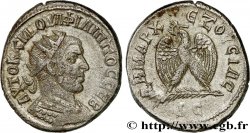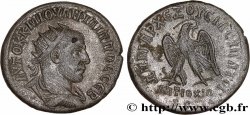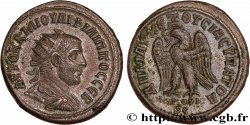bpv_192776 - PHILIPPUS Tétradrachme syro-phénicien
无库存.
所有在网站上销售的产品 (2014)
价格 : 190.00 €
所有在网站上销售的产品 (2014)
价格 : 190.00 €
种类 Tétradrachme syro-phénicien
日期: 244
铸币厂名称/城市 Antioche, Syrie, Séleucie et Piérie
材质 billon
直径 26,00 mm
模子方针 6 h.
重量 12,46 g.
关于品相的说明
Bonne frappe bien centrée, légère trace de circulation sur le ventre de l’aigle, petites rayures sur une toute petite zone devant le front de l’empereur, pratiquement invisibles sauf à la loupe
出版目录中的项代码 :
家谱
Cet exemplaire, qui est celui qui illustre le Prieur, est le 0310_011 de la base TSP
正面
正面的说明书 Buste lauré, drapé et cuirassé de Philippe Ier à droite, vu de trois quarts en arrière (A*2).
正面铭文 AUTOK K M IOUL FILIPPOU SEB, (Autokratoros Kaisaros Markos Ioulios Filippos Sebastos)
正面的翻译 (L’empereur césar Marc Jules Philippe auguste).
背面
背面的文字 S|C// MON VRB À L’EXERGUE // SIGMA MINUSCULE DANS LE CHAMP.
背面的说明书 Aigle debout à droite, les ailes déployées, tête et queue à gauche, tenant une couronne feuillée dans son bec, sans ligne de terre.
背面铭文 DHMARC - EX OUSIAS / S
背面的翻译 (Revêtu de la puissance tribunitienne/ Monnaie de la Ville / avec l’accord du Sénat).
评论
Les premières émissions de Philippe se subdivisent en frappes sans marque d’officine et avec ligne de terre, frappes sans marque d’officine et sans ligne de terre, puis frappes avec marques d’officine et sans ligne de terre.
Notre exemplaire appartient à cette catégorie, pour la sixième officine (Sigma minuscule), où l’on remarque à quel point la graphie du S est proche de notre version majuscule. On notera l’existence de deux variantes non distinguées dans le Prieur, l’une avec le sigma en majuscule et l’autre avec cette lettre minuscule et inversée.
La question du lieu de frappe, au sens de fabrication et non de mise en circulation, a été tranchée par H. R. Baldus, Moneta Urbis - Antioxia, Francfort 1969, et il semble bien que ces monnaies ont été fabriquées à Rome, plutôt qu’à Antioche.
Le raisonnement de H.R. Baldus concernant cette émission de Philippe repose avant tout sur la signature de l’atelier au revers : dans le monde romain, l’Urbs, la Ville, ne peut être que Rome. Le cas n’est pas isolé et il a été déterminé, par exemple, que des tétradrachmes d’Alexandrie pour Sévère Alexandre avaient été frappés à Rome puis envoyés en Égypte ; on peut penser que des questions de prix de revient et de qualité de fabrication furent à l’origine de ces migrations.
Effectivement, les portraits de cette émission sont exceptionnellement bons, équivalents aux meilleurs sesterces de l’atelier de Rome.
Autre particularité de cette émission, le retour du SC, disparu des revers entre 242 et 244, après avoir remplacé à Antioche le Delta Eta apparu en 215, et jamais vu dans un autre atelier officiel. Si nous suivons la logique développée pour ces émissions, il faut croire que ces frappes de Philippe ont reçu l’assentiment (au moins) et le financement (au plus) du sénat d’Antioche. Une gigantesque rançon ayant été payée aux Perses pour abréger la guerre, le propre frère de Philippe étant gouverneur de Syrie, sa propre famille en étant originaire, on peut au moins penser que le Sénat regagna de son importance de l’époque des Sévères. La réputation de Priscus étant de pressurer la population - au point de susciter l’usurpateur Jotapian - on peut aussi penser que le produit de ces spoliations servit à frapper des tétradrachmes au portrait et donc à la gloire de l’Empereur.
On note que les sigma sont gravés en C, sauf celui de l’officine.
Dans la base TSP maintenue par Michel Prieur, quarante-six exemplaires sont maintenant répertoriés pour la sixième officine dont en musées Berlin, ANS (2), Yale ex Doura, British Museum et Gaziantep.
The first issues of Philippe are subdivided into strikes without an office mark and with a ground line, strikes without an office mark and without a ground line, then strikes with an office mark and without a ground line..
Our example belongs to this category, for the sixth pharmacy (lowercase Sigma), where we notice how close the spelling of the S is to our capital version.. It should be noted that there are two undistinguished variants in the Prior, one with the sigma in capital letters and the other with this letter in lower case and inverted..
The question of the place of minting, in the sense of manufacture and not of putting into circulation, was decided by H. R. Baldus, Moneta Urbis - Antioxia, Frankfurt 1969, and it seems that these coins were made in Rome, rather than in Antioch.
H's reasoning. R. Baldus's opinion on this issue of Philip rests above all on the workshop signature on the reverse: in the Roman world, the Urbs, the City, can only be Rome.. This is not an isolated case and it has been determined, for example, that Alexandrian tetradrachms for Severus Alexander were minted in Rome and then sent to Egypt; it is possible to assume that questions of cost price and manufacturing quality were at the origin of these migrations..
Indeed, the portraits in this issue are exceptionally good, equivalent to the best sesterces from the Roman workshop..
Another particularity of this issue is the return of the SC, which disappeared from the reverses between 242 and 244, after having replaced the Delta Eta in Antioch, which appeared in 215, and never seen in another official mint.. If we follow the logic developed for these emissions, we must believe that these strikes of Philip received the assent (at least) and the financing (at most) of the senate of Antioch. A gigantic ransom having been paid to the Persians to shorten the war, Philip's own brother being governor of Syria, his own family being from there, one can at least think that the Senate regained its importance of the time of the Severans. Priscus's reputation for squeezing the population - to the point of giving rise to the usurper Jotapian - we can also think that the product of these spoliations was used to strike tetradrachms with the portrait and therefore to the glory of the Emperor..
Note that the sigmas are engraved in C, except for the one in the pharmacy.
In the TSP database maintained by Michel Prieur, forty-six examples are now listed for the sixth office, including in museums Berlin, ANS (2), Yale ex Doura, British Museum and Gaziantep
Notre exemplaire appartient à cette catégorie, pour la sixième officine (Sigma minuscule), où l’on remarque à quel point la graphie du S est proche de notre version majuscule. On notera l’existence de deux variantes non distinguées dans le Prieur, l’une avec le sigma en majuscule et l’autre avec cette lettre minuscule et inversée.
La question du lieu de frappe, au sens de fabrication et non de mise en circulation, a été tranchée par H. R. Baldus, Moneta Urbis - Antioxia, Francfort 1969, et il semble bien que ces monnaies ont été fabriquées à Rome, plutôt qu’à Antioche.
Le raisonnement de H.R. Baldus concernant cette émission de Philippe repose avant tout sur la signature de l’atelier au revers : dans le monde romain, l’Urbs, la Ville, ne peut être que Rome. Le cas n’est pas isolé et il a été déterminé, par exemple, que des tétradrachmes d’Alexandrie pour Sévère Alexandre avaient été frappés à Rome puis envoyés en Égypte ; on peut penser que des questions de prix de revient et de qualité de fabrication furent à l’origine de ces migrations.
Effectivement, les portraits de cette émission sont exceptionnellement bons, équivalents aux meilleurs sesterces de l’atelier de Rome.
Autre particularité de cette émission, le retour du SC, disparu des revers entre 242 et 244, après avoir remplacé à Antioche le Delta Eta apparu en 215, et jamais vu dans un autre atelier officiel. Si nous suivons la logique développée pour ces émissions, il faut croire que ces frappes de Philippe ont reçu l’assentiment (au moins) et le financement (au plus) du sénat d’Antioche. Une gigantesque rançon ayant été payée aux Perses pour abréger la guerre, le propre frère de Philippe étant gouverneur de Syrie, sa propre famille en étant originaire, on peut au moins penser que le Sénat regagna de son importance de l’époque des Sévères. La réputation de Priscus étant de pressurer la population - au point de susciter l’usurpateur Jotapian - on peut aussi penser que le produit de ces spoliations servit à frapper des tétradrachmes au portrait et donc à la gloire de l’Empereur.
On note que les sigma sont gravés en C, sauf celui de l’officine.
Dans la base TSP maintenue par Michel Prieur, quarante-six exemplaires sont maintenant répertoriés pour la sixième officine dont en musées Berlin, ANS (2), Yale ex Doura, British Museum et Gaziantep.
The first issues of Philippe are subdivided into strikes without an office mark and with a ground line, strikes without an office mark and without a ground line, then strikes with an office mark and without a ground line..
Our example belongs to this category, for the sixth pharmacy (lowercase Sigma), where we notice how close the spelling of the S is to our capital version.. It should be noted that there are two undistinguished variants in the Prior, one with the sigma in capital letters and the other with this letter in lower case and inverted..
The question of the place of minting, in the sense of manufacture and not of putting into circulation, was decided by H. R. Baldus, Moneta Urbis - Antioxia, Frankfurt 1969, and it seems that these coins were made in Rome, rather than in Antioch.
H's reasoning. R. Baldus's opinion on this issue of Philip rests above all on the workshop signature on the reverse: in the Roman world, the Urbs, the City, can only be Rome.. This is not an isolated case and it has been determined, for example, that Alexandrian tetradrachms for Severus Alexander were minted in Rome and then sent to Egypt; it is possible to assume that questions of cost price and manufacturing quality were at the origin of these migrations..
Indeed, the portraits in this issue are exceptionally good, equivalent to the best sesterces from the Roman workshop..
Another particularity of this issue is the return of the SC, which disappeared from the reverses between 242 and 244, after having replaced the Delta Eta in Antioch, which appeared in 215, and never seen in another official mint.. If we follow the logic developed for these emissions, we must believe that these strikes of Philip received the assent (at least) and the financing (at most) of the senate of Antioch. A gigantic ransom having been paid to the Persians to shorten the war, Philip's own brother being governor of Syria, his own family being from there, one can at least think that the Senate regained its importance of the time of the Severans. Priscus's reputation for squeezing the population - to the point of giving rise to the usurper Jotapian - we can also think that the product of these spoliations was used to strike tetradrachms with the portrait and therefore to the glory of the Emperor..
Note that the sigmas are engraved in C, except for the one in the pharmacy.
In the TSP database maintained by Michel Prieur, forty-six examples are now listed for the sixth office, including in museums Berlin, ANS (2), Yale ex Doura, British Museum and Gaziantep







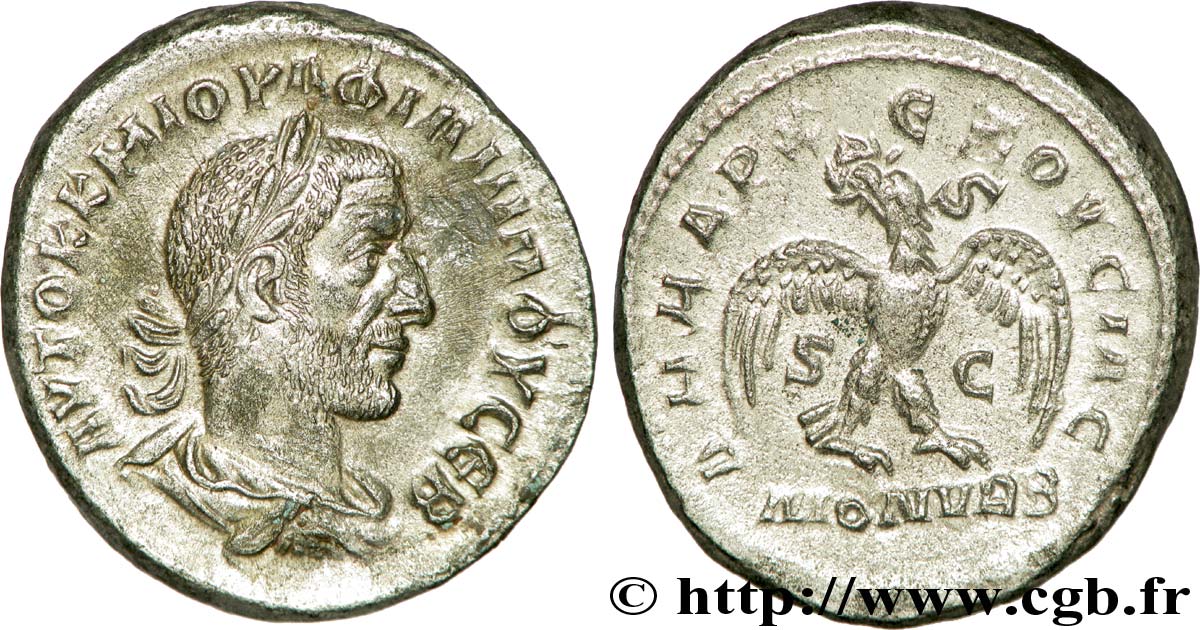
 对产品描述纠错
对产品描述纠错 打印
打印 分享我的选择
分享我的选择 提问
提问 Consign / sell
Consign / sell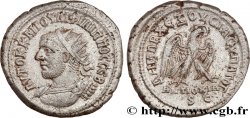
 产品介绍
产品介绍